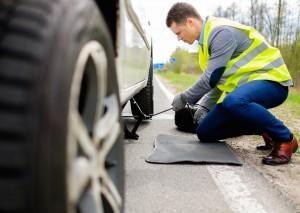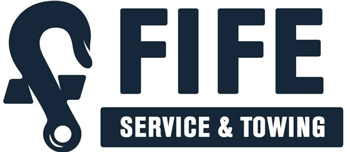- We dispatch 24-hours a day, 7 days a week, 365 days a year!
- Federal Way: (253) 292-6170
- Tacoma: (253) 922-8784
What You Might Not Know About Using and Maintaining Your Spare Tire
How Preparation Helps Expedite Towing Calls in Lakewood
December 11, 2017Why do Cars Get Impounded?
April 3, 2018
Everything You Need to Know About Using and Maintaining Your Spare Tire
Everyone loves donuts, right?
You know: chocolate frosted, glazed, French cruller.
Sure, everyone loves donuts, alright—until you’re stuck on the side of the road with a flat tire and have to replace it with that factory spare otherwise known as everyone’s least favorite flavor of donut: rubber.
Whether you’ve never installed a spare or you can do it with the speed of a Nascar pit crew, this post will cover everything you need to know about your donut.
Stranded without a spare? Call Fife Towing in Puyallup and get home safe!
For Emergency Use Only
To some folks, this one is common sense, but not everyone knows that most modern cars are equipped with a temporary compact spare tire. You’ll notice that it’s much smaller and thinner than the rest of your tires. Car manufacturers include this mini donut because there’s not really any place to fit a full-sized tire (plus real tires are a lot pricier!).
The spare is not a replacement. The purpose of the donut is to get you off the side of the road so you can get home safely or make your way to a reliable mechanic to get your tire fixed or replaced. Think of your spare tire as a tightrope walker’s safety net. It’s there if you need it, but it’s not something you ever want to plan to use.
How Far and How Fast?
Not very far. Not very fast.
Your donut isn’t designed for long-term use (that’s why they’re so cheap!), so manufacturers recommend that you don’t drive further than fifty miles on a spare tire. But really, unless you’re in the middle of the desert, you shouldn’t even drive that far. Get home, get to a mechanic, and get things fixed.
Similarly, the donut is too narrow to support high speeds. Never exceed 50 miles per hour when your spare is attached. Driving on a donut is kind of like walking with crutches: if you try to push it too far or too fast, you’re going to break more than is already broken.
If you need a good way to recall the limits of your spare, just remember the 50/50 donut rule: 50 miles per hour for 50 miles max.
What Happens If I Abuse My Donut?
Nothing good. That’s for sure.
Driving farther than the recommended fifty miles puts you at risk of a blowout, which can be dangerous at worst and costly at best. Bent rims and broken axles aren’t cheap, and repairs could run as much as $1000 once you account for parts and labor.
Beyond the immediate damage caused by a blowout, driving too far on a spare just isn’t good for your car’s functionality or long-term health. For starters, the reduced size of a donut makes the entire car handle and brake differently.
Furthermore, if your car is equipped electronic traction or stability controls, they likely won’t work properly while the donut is attached.
Perhaps worst of all, driving too long on your donut is likely to wear out your other tires and disturb their alignment, just leading to even more money lost in car repairs.
How To Change a Flat Tire
Now that you know everything NOT to do with your donut, let’s talk about putting it to good use. For starters, though, don’t even attempt to change the tire if you aren’t pulled over in a safe area on level ground. A mishap on a hill could spell disaster. Call a professional to change it for you or tow it to safety.
Step One: Safety First
If you’ve decided to change your tire, apply your parking brake and turn on your hazard lights to alert other motorists. If it’s dark out, you may want to also light emergency flares a safe distance from your vehicle.
Before you get started on the flat, you should secure the other tires with wheel wedges, bricks, large rocks, or some other appropriately sized heavy object. When replacing a front tire, the blocks should go behind the rear tires. If you are changing a rear tire, the blocks go in front of the front tires.
Step Two: Loosen the Lug Nuts
Your car should come equipped with a lug wrench that you can use to turn the lug nuts a half turn each or so. They can get quite stuck, so don’t be afraid to put the strength of your entire body into it. Don’t remove the nuts completely yet. Just get them all loose enough that you can unscrew them by hand later on.
Step Three: Jack the Vehicle
Follow the instructions for operating the jack that comes with your vehicle. The manual should specify the best location to attach the jack, as well as appropriate instructions for lifting the vehicle.
Do not let the jack lull you into a false sense of security. Never go underneath the car while it is elevated.
Step Four: Remove the Flat Tire
Start by unscrewing the lug nuts by hand. If any of them are still tight DO NOT attempt to force them while the car is jacked. To avoid any risk of knocking the car over, lower the jack and return to step 2.
Once you’ve got all of the lug nuts removed and stored in a safe place, you should be able to pull the flat tire out of holding.
Step Five: Attach the Donut
Lift the spare tire over the lug bolts, pushing firmly until you have room to reattach the lug nuts. Tighten them by hand. Do not use the lug wrench yet.
Once the lug nuts are hand tightened, follow the jack instructions to lower the vehicle until the spare is touching the ground. Now that the car is lowered safely, you can finish tightening the lug nuts all the way using the lug wrench.
Step Six: Remove the Jack
With the lug nuts secured tightly, you are safe to lower the vehicle completely and remove the jack. Stow your tools and the flat tire, and take the shortest route to a mechanic to get your tires replaced or fixed by a professional.
Not Up For Changing Your Own Tire?
If you’re stranded and don’t feel comfortable changing the flat, Fife Towing has 65 years of experience providing roadside assistance and towing in Puyallup and getting drivers home safely.
Don’t hesitate to call!


